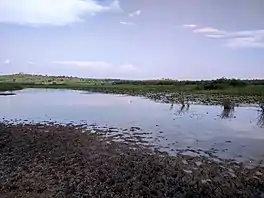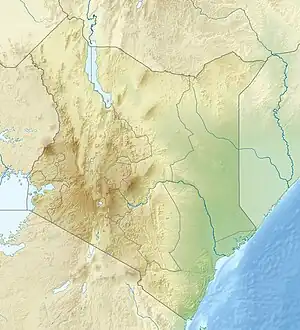Yala Swamp
The Yala Swamp is a wetland region of about 175 square kilometres (68 sq mi) in Western Kenya.
| Yala Swamp | |
|---|---|
 Egyptian white lotus (Nymphaea lotus) on the north shore of Yala Swamp in Bar Olengo | |
 Yala Swamp | |
| Location | Yala Swamp, Kenya |
| Coordinates | 0.038°N 34.082°E |
| River sources | Yala River, Nzoia River |
| Basin countries | Kenya, Uganda |
| Surface area | 175 square kilometres (68 sq mi) |
Location
The Yala Swamp at the mouth of the Yala River covers about 175 square kilometres (68 sq mi) along the northeastern shore of Lake Victoria.[1] The swamp contains the 1,500 hectares (3,700 acres) Lake Kanyaboli, a freshwater deltaic wetland with an average depth of 3 metres (9.8 ft), which is fed by the floodwaters of the Nzoia and Yala rivers and by the backflow of water from Lake Victoria.[2] The wetland is in Siaya and Busia counties in Kenya. It acts as a filter for waters that flow into Lake Victoria from two major rivers, the Yala River and Nzoia River. It is sometimes considered the source of the Nile.
In the past the Yala River flowed through the eastern 20% of the Yala Swamp into Lake Kanyaboli, then into the main swamp, and then through a small gulf into Lake Victoria. Today the eastern part of the swamp has been drained, and the river flows directly into the 8,000 hectares (20,000 acres) main swamp. It is cut off from Lake Kanyaboli by a silt-clay dyke. Lake Kanyaboli now receives its water from the surrounding catchment area and from back-seepage from the swamp. The river's gulf has been cut off from the lake by a culvert, which created the 500 hectares (1,200 acres) Lake Sare through back-flooding.[3]Yala Swamp is a "vast wetland protecting the mouth of the Nzoia River and the north-eastern shore of Lake Victoria in Kenya. Lake Kanyaboli, which still shelters some of the fish species that have disappeared from Lake Victoria, is part of the Yala Swamp complex.
"The swamp's large stand of papyrus reeds and other sedges collect water during the rains, stabilizes the muddy soil, traps sediment and filters pollutants. These ecological services help to keep Lake Victoria waters clear, reduce soil erosion and minimize the impacts of floods."[1] It is also home to a number of bird species, including papyrus endemics - birds only found in papyrus swamp habitat. However, currently Yala Swamp is being converted into a massive industrial agricultural operation by Dominion Farms Limited, an Oklahoma-based company that produces rice, bananas, and tilapia. Yala Swamp is located in Siaya District, Nyanza Province and Busia District, Western Province.[2] Ramogi Hill, a sacred site to the Luo people, is contained within the swamp.
Ecology
The swamps harbour endangered fish species Oreochromis esculentus and Oreochromis variabilis that have disappeared from Lake Victoria itself. The Sitatunga antelope (Tragecephalus spekii) still lives in the swamps’ papyrus. BirdLife International classifies the Yala Swamp among Kenya’s 60 Important Bird Areas. Some of the birds that live there are the blue-breasted bee-eater, the papyrus gonolek, the swamp flycatcher, the papyrus canary, the white-winged swamp warbler and the Baillon's crake.
A 2005 report noted changes in Lake Sare that threatened the lake ecosystem through eutrophication and pollution. It recommended an inclusive management plan for the Yala swamp complex to prevent further degradation of the ecosystem.[4] As of 2019 BirdLife International scored the threat to the swamp complex as high, and was pessimistic about action being taken.[3]
References
Sources
- Gichuki, John; Maithya, Jacob; Masai, D. M. (September 2005), Recent ecological changes in of Lake Sare, western Kenya, Kenya Marine and Fisheries Research Institute, retrieved 2021-03-07
- Okuna, Patience (2019), Threats to the survival of river Yala in Kenya, Munich: GRIN Verlag, retrieved 2021-03-06
- Lake Kanyaboli – Kenya, Global Nature Fund, retrieved 2021-03-07
- Yala Swamp Complex, BirdLife International, retrieved 2021-03-07
External links
- Biodiversity and Sustainable Management of a Tropical Wetland Lake Ecosystem:A Case Study of Lake Kanyaboli, Kenya by Romulus Abila
- more info at global response
- a case study of the Yala swamp by Romulus Abila of Maseno University Kenya